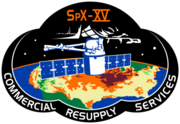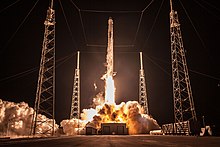 Dragon spacecraft on approach to ISS Dragon spacecraft on approach to ISS | |
| Names | SpX-15 |
|---|---|
| Mission type | ISS resupply |
| Operator | SpaceX |
| COSPAR ID | 2018-055A |
| SATCAT no. | 43522 |
| Mission duration | 35 days, 12 hours, 35 minutes |
| Spacecraft properties | |
| Spacecraft | Dragon 1 C111 |
| Spacecraft type | Dragon 1 |
| Manufacturer | SpaceX |
| Dry mass | 4,200 kg (9,300 lb) |
| Dimensions | Height: 6.1 m (20 ft) Diameter: 3.7 m (12 ft) |
| Start of mission | |
| Launch date | 29 June 2018, 09:42 (2018-06-29UTC09:42) UTC |
| Rocket | Falcon 9 Full Thrust Block 4 (B1045.2) |
| Launch site | Cape Canaveral, SLC-40 |
| Contractor | SpaceX |
| End of mission | |
| Disposal | Recovered |
| Landing date | 3 August 2018, 22:17 (2018-08-03UTC22:18) UTC |
| Landing site | Pacific Ocean off Baja California |
| Orbital parameters | |
| Reference system | Geocentric |
| Regime | Low Earth |
| Inclination | 51.6° |
| Berthing at ISS | |
| Berthing port | Harmony nadir |
| RMS capture | 2 July 2018, 10:54 UTC |
| Berthing date | 2 July 2018, 13:50 UTC |
| Unberthing date | 3 August 2018 |
| RMS release | 3 August 2018, 16:38 UTC |
| Time berthed | 31 days |
| Cargo | |
| Mass | 2,697 kg (5,946 lb) |
| Pressurised | 1,712 kg (3,774 lb) |
| Unpressurised | 985 kg (2,172 lb) |
 NASA SpX-15 mission patch Commercial Resupply Services← OA-9ENG-10 → Cargo Dragon← SpaceX CRS-14SpaceX CRS-16 → | |
SpaceX CRS-15, also known as SpX-15, was a Commercial Resupply Service mission to the International Space Station launched 29 June 2018 aboard a Falcon 9 rocket. The mission was contracted by NASA and flown by SpaceX.
Launch

In early 2015, NASA awarded a contract extension to SpaceX for three additional CRS missions (CRS-13 to CRS-15). In June 2016, a NASA Inspector General report had this mission manifested for April 2018, but this was pushed back, first to 6 June, to 9 June, to 28 June and finally to 29 June 2018.
The mission launched on 29 June 2018 at 09:42 UTC aboard a Falcon 9 rocket from Cape Canaveral Air Force Station Launch Complex 40. The SpaceX Dragon spacecraft rendezvoused with the International Space Station on 2 July 2018. It was captured by the Canadarm2 at 10:54 UTC and was berthed to the Harmony node at 13:50 UTC. On 3 August 2018, Dragon was released from ISS at 16:38 UTC and deorbited, splashing down in the Pacific Ocean approximately 5 hours later at 22:17 UTC, returning more than 1,700 kg (3,748 lb) of cargo to Earth.
It is reported that the Dragon spacecraft may have experienced some parachute anomaly during its flight to the ISS, but it did not prevent the capsule from successful splashdown.
Payload
NASA contracted for the CRS-15 mission from SpaceX and therefore determined the primary payload, date/time of launch, and orbital parameters for the Dragon space capsule. According to a NASA mission overview, CRS-15 carried a total of 2,697 kg (5,946 lb) of total cargo, divided between 1,712 kg (3,774 lb) of pressurized material and 985 kg (2,172 lb) of unpressurized cargo. The external payloads manifested for this flight were ECOSTRESS and a Latching End Effector for Canadarm2. CubeSats included on this flight were three Biarri-Squad satellites built by Boeing for a multinational partnership led by the U.S. National Reconnaissance Office, and three satellites making up the Japanese-sponsored Birds-2 program: BHUTAN-1 from Bhutan, Maya-1 from the Philippines, and UiTMSAT-1 from Malaysia. Furthermore, it contained an interactive artwork by artist Nahum entitled The Contour of Presence, a collaboration with the International Space University, Space Application Services and the European Space Agency.
The following is a breakdown of cargo bound for the ISS:
- Science investigations: 1,233 kg (2,718 lb)
- Crew supplies: 205 kg (452 lb)
- Vehicle hardware: 178 kg (392 lb)
- Spacewalk equipment: 63 kg (139 lb)
- Computer resources: 21 kg (46 lb)
- Russian hardware: 12 kg (26 lb)
- External payloads: 985 kg (2,172 lb)
- ECOSTRESS: 550 kg (1,213 lb)
- Latching End Effector: 435 kg (959 lb)
Gallery
SpaceX CRS-15See also
- Uncrewed spaceflights to the International Space Station
- List of Falcon 9 and Falcon Heavy launches
- 2018 in spaceflight
- Artworks launched into space
- Birds-2
References
- ^ Clark, Stephen (29 June 2018). "SpaceX launches AI-enabled robot companion, vegetation monitor to space station". Spaceflight Now. Retrieved 4 July 2018.
- ^ Clark, Stephen (3 August 2018). "SpaceX cargo capsule comes back to Earth from space station". Spaceflight Now. Retrieved 4 August 2018.
- ^ Gebhardt, Chris (2 July 2018). "SpaceX CRS-15 Dragon arrives at ISS with science/crew supply payloads". NASASpaceFlight.com. Retrieved 4 July 2018.
- de Selding, Peter B. (24 February 2016). "SpaceX wins 5 new space station cargo missions in NASA contract estimated at $700 million". SpaceNews. Retrieved 24 February 2016.
- NASA Office of Inspector General (28 June 2016). NASA's Response to SpaceX's June 2015 Launch Failure: Impacts on Commercial Resupply of the International Space Station (PDF) (Report). NASA Office of Inspector General. p. 13. Report No. IG-16-025. Retrieved 18 July 2016.
- Clark, Stephen (4 June 2018). "Launch Schedule". Spaceflight Now. Archived from the original on 15 June 2018.
- Berger, Eric (7 March 2019). "Dragon has docked—but the real pucker moment for SpaceX's capsule awaits". Ars Technica. Retrieved 8 March 2019.
- ^ "SpaceX CRS-15 Mission Overview" (PDF). NASA. Retrieved 29 June 2018.
- Kenol, Jules; Love, John (2016). Research Capability of ISS for a Wide Spectrum of Science Disciplines, Including Materials Science (PDF). Materials in the Space Environment Workshop. 17 May 2016. Italian Space Agency, Rome.
- Scimemi, Sam (July 2016). International Space Station Status July 2016 (PDF) (Technical report). NASA. Retrieved 29 July 2016.
- Graham, William (28 June 2018). "Final Block 4 Falcon 9 launches CRS-15 Dragon". NASASpaceFlight.com. Retrieved 8 October 2018.
- ""It's official: I have an artwork in outer space"". Makery. Retrieved 22 February 2019.
External links
 Media related to SpaceX CRS-15 at Wikimedia Commons
Media related to SpaceX CRS-15 at Wikimedia Commons- Dragon website at SpaceX.com
- Commercial Resupply Services at NASA.gov
| SpaceX Dragon 1 and Dragon 2 | |||||||
|---|---|---|---|---|---|---|---|
| Spacecraft |   | ||||||
| Hardware | |||||||
| Missions |
| ||||||
| |||||||
| SpaceX missions and payloads | |||||||||||||||||||||
|---|---|---|---|---|---|---|---|---|---|---|---|---|---|---|---|---|---|---|---|---|---|
| Launch vehicles | |||||||||||||||||||||
| Falcon 1 missions |
| ||||||||||||||||||||
| Falcon 9 missions |
| ||||||||||||||||||||
| Falcon Heavy missions |
| ||||||||||||||||||||
| Starship missions |
| ||||||||||||||||||||
| |||||||||||||||||||||
| Uncrewed spaceflights to the International Space Station | ||
|---|---|---|
| ||
| 2000–2004 |  | |
| 2005–2009 | ||
| 2010–2014 | ||
| 2015–2019 | ||
| 2020–2024 | ||
| Future | ||
| Spacecraft | ||
| ||


